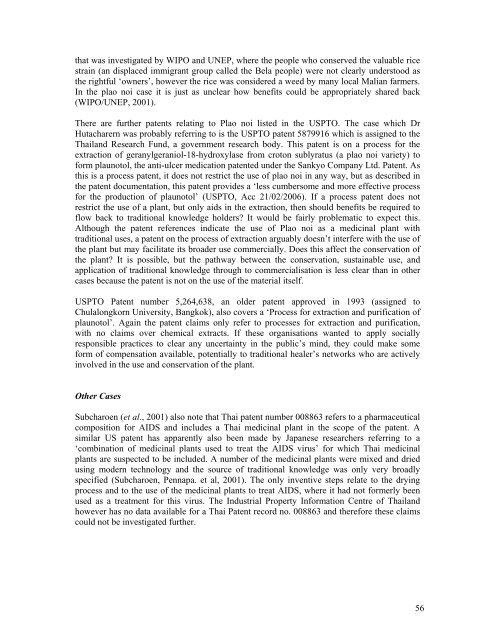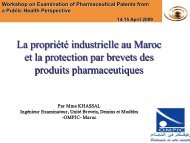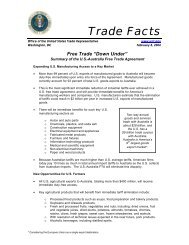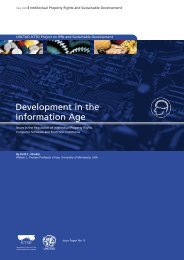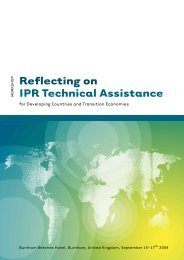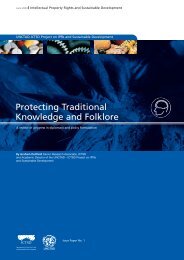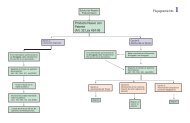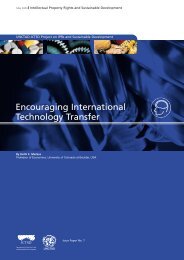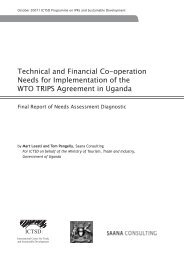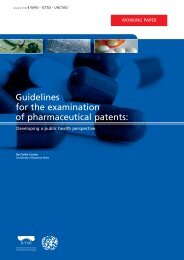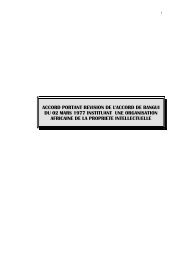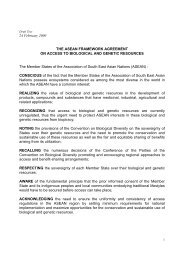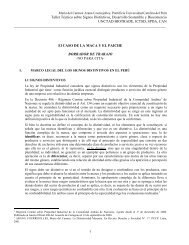Governance and Micropolitics of Traditional ... - IPRsonline.org
Governance and Micropolitics of Traditional ... - IPRsonline.org
Governance and Micropolitics of Traditional ... - IPRsonline.org
Create successful ePaper yourself
Turn your PDF publications into a flip-book with our unique Google optimized e-Paper software.
that was investigated by WIPO <strong>and</strong> UNEP, where the people who conserved the valuable rice<br />
strain (an displaced immigrant group called the Bela people) were not clearly understood as<br />
the rightful ‘owners’, however the rice was considered a weed by many local Malian farmers.<br />
In the plao noi case it is just as unclear how benefits could be appropriately shared back<br />
(WIPO/UNEP, 2001).<br />
There are further patents relating to Plao noi listed in the USPTO. The case which Dr<br />
Hutacharern was probably referring to is the USPTO patent 5879916 which is assigned to the<br />
Thail<strong>and</strong> Research Fund, a government research body. This patent is on a process for the<br />
extraction <strong>of</strong> geranylgeraniol-18-hydroxylase from croton sublyratus (a plao noi variety) to<br />
form plaunotol, the anti-ulcer medication patented under the Sankyo Company Ltd. Patent. As<br />
this is a process patent, it does not restrict the use <strong>of</strong> plao noi in any way, but as described in<br />
the patent documentation, this patent provides a ‘less cumbersome <strong>and</strong> more effective process<br />
for the production <strong>of</strong> plaunotol’ (USPTO, Acc 21/02/2006). If a process patent does not<br />
restrict the use <strong>of</strong> a plant, but only aids in the extraction, then should benefits be required to<br />
flow back to traditional knowledge holders? It would be fairly problematic to expect this.<br />
Although the patent references indicate the use <strong>of</strong> Plao noi as a medicinal plant with<br />
traditional uses, a patent on the process <strong>of</strong> extraction arguably doesn’t interfere with the use <strong>of</strong><br />
the plant but may facilitate its broader use commercially. Does this affect the conservation <strong>of</strong><br />
the plant? It is possible, but the pathway between the conservation, sustainable use, <strong>and</strong><br />
application <strong>of</strong> traditional knowledge through to commercialisation is less clear than in other<br />
cases because the patent is not on the use <strong>of</strong> the material itself.<br />
USPTO Patent number 5,264,638, an older patent approved in 1993 (assigned to<br />
Chulalongkorn University, Bangkok), also covers a ‘Process for extraction <strong>and</strong> purification <strong>of</strong><br />
plaunotol’. Again the patent claims only refer to processes for extraction <strong>and</strong> purification,<br />
with no claims over chemical extracts. If these <strong>org</strong>anisations wanted to apply socially<br />
responsible practices to clear any uncertainty in the public’s mind, they could make some<br />
form <strong>of</strong> compensation available, potentially to traditional healer’s networks who are actively<br />
involved in the use <strong>and</strong> conservation <strong>of</strong> the plant.<br />
Other Cases<br />
Subcharoen (et al., 2001) also note that Thai patent number 008863 refers to a pharmaceutical<br />
composition for AIDS <strong>and</strong> includes a Thai medicinal plant in the scope <strong>of</strong> the patent. A<br />
similar US patent has apparently also been made by Japanese researchers referring to a<br />
‘combination <strong>of</strong> medicinal plants used to treat the AIDS virus’ for which Thai medicinal<br />
plants are suspected to be included. A number <strong>of</strong> the medicinal plants were mixed <strong>and</strong> dried<br />
using modern technology <strong>and</strong> the source <strong>of</strong> traditional knowledge was only very broadly<br />
specified (Subcharoen, Pennapa. et al, 2001). The only inventive steps relate to the drying<br />
process <strong>and</strong> to the use <strong>of</strong> the medicinal plants to treat AIDS, where it had not formerly been<br />
used as a treatment for this virus. The Industrial Property Information Centre <strong>of</strong> Thail<strong>and</strong><br />
however has no data available for a Thai Patent record no. 008863 <strong>and</strong> therefore these claims<br />
could not be investigated further.<br />
56


